
Long Tail Keywords are the key to SEO and content marketing in today’s world.
SEO starts with Keyword research and once a few keywords are selected, the most obvious step is to filter keywords by relevancy and search volumes.
If you ask any webmaster or SEO professional, they would want their website to rank on the keywords with the highest search volumes.
However, immediately after filtering keywords by search volumes, one has to plan how to rank the content and the website for the high-volume keywords.
Now as soon as the high-volume keyword is decided and any SEO professional starts with some research and some planning.
The first step of this planning and one of the most IMP parts of SEO is competitor research.
If you ask me, once the keywords are decided, I manually search with those in Google and find out the sites that are ranking at the top for those keywords.
I start analyzing those sites to figure out why those websites are ranking where they are ranking.
When you see the sites ranking in the top results, more often than not, you will say that ranking among these sites will not be an easy task.
It will not only take a lot of effort but it will also take a lot of time.
And in such a situation, the SEO professional will continue working towards targeting those keywords but will try to come up with something that starts driving organic traffic asap.
This is where Long tail keywords come into the picture.
Long Tail Keywords – What are they
Now let us understand the nature of Long Tail Keywords.
Long tail keywords are like buried jewels in the wide internet world.
They may not act as high search volume keywords or as prominent head phrases, but they sure carry a punch when it comes to reaching the correct audience.
According to a recently published report, long tail keywords have grown increasingly important in the digital world, with 56% of searchers using queries of three or more words, compared to just 7% using single-word searches or acronyms.
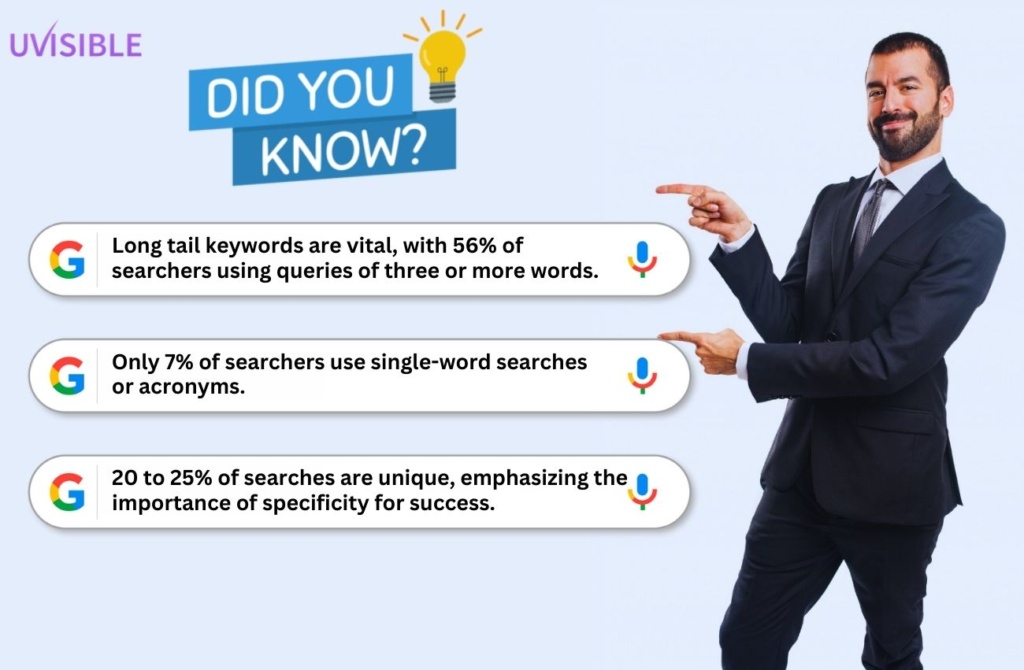
With 20 to 25% of Google searches being unique and users utilising lengthier queries, it’s evident that specificity is the key to success.
So, let’s go on an adventure to discover the mysteries of long tail keywords a.k.a low competition keywords!
First and foremost, these aren’t the short and snappy keywords you’re used to hearing about.
Long tail keywords are specific, often long search queries entered into search engines by users.
They tell search engines not just what information users or potential consumers seek, but also why.
It’s like sending a personalised invitation to search engines to your website!
Let’s take it a step further.
Assume you’re looking for information on “long tail keywords” (see what I did there?).
Now, if you just searched for one of the high search volume keywords like “SEO services” you’d be inundated with results, right?
However, by adding a little more precision and looking for “what are the best SEO services and how to identify them” you’re entering a long tail keyword area.
This is where the magic happens!
The point is, while each long tail keyword will never be a high search volume keywords when combined, they account for a sizable portion of total searches on platforms such as Google.
It’s like a secret treasure trove just waiting to be found!
The phrase “long tail” refers to the curve’s tail end, which represents these less common yet highly detailed search requests.

You may be asking why you should worry about long tail keywords.
There are plenty of solid reasons, folks!
For starters, long tail keywords frequently have less competition than popular head terms.
Consider this: everyone is attempting to rank for those high search volume keywords, which means it might be a difficult struggle.
Long tail keywords, on the other hand, give you a higher chance of sticking out from the throng and capturing that coveted top-ranking position at the SERP.
Moreover, they can also give you vital insights regarding your target demographic.
You may acquire a better insight into their requirements, interests, and pain areas by analysing the precise long tail keywords people use to reach your website or content.
It’s like getting a peek inside their search patterns and learning what makes them tick.
With this information, you can adapt your content strategy and marketing efforts to better resonate with your target demographic and increase engagement.
Also Read: Ultimate Guide to Content Marketing
Low Search Volume
One of the ways to classify long tail keywords is their search volume. Long tail keywords are those keywords whose search volumes are just a few hundred and not even thousands.
People often think that long tail keywords are mainly those with 4-5 + words, but by definition, keywords with low search volumes are called long tail keywords.
4-5 Words Long
Another way of classifying long tail keywords is that they are usually of 4-5 words or more.
As mentioned above, most people call queries with 4-5+ words of long tail keywords.
However, to generalize and relate the common belief, I am considering such words as long tail keywords.
Specific Intent
It is seen that long tail keywords have a very specific intent. You will find that in such keywords, users are asking a question.
They are asking for a way to do a thing
They are asking for a process
They are finding a place like a Salon, Restaurant, Clinic etc
In all of the above cases, the user is searching for something very specific and the search is narrower.
In the case of these keywords, the search volume would be reasonable.
*Caution – Not all keywords of 4-5 words would have low search volumes. Some of such keywords can have good search volume. If we go by the definition, they would not be called long tail keywords.
Low Keyword Difficulty
There are various keyword tools available in the market that have come up with a metric called “Keyword Difficulty”.
Keyword difficulty is a score from 0-100 that indicates how difficult it would be to rank a website for this keyword in organic search results.
The higher the score, the more is difficult to rank for that keyword.
For Long tail keywords, these tools will show a low keyword difficulty score as they apparently will be low competition keywords.
Long Tail Keywords Examples
Now, I’m sure you’re eager to hear some instances of long tail keywords, don’t you?
Buckle up, they’re coming!
We’ve got “What is Technical SEO Audit Service,” “low competition keywords for SEO Audit,” and “long tail keywords in SEO Audit strategies.”
Notice how they’re more specialised and focused than broad keywords like “SEO Audit Services” or “SEO Audit“? That is the long tail keyword’s strength!
So, don’t underestimate the attractiveness of long tail keywords.
They may not be the most visually appealing, but they can attract highly engaged and relevant visitors.
Long tail keywords help you increase your website’s exposure, outrank your competitors, and engage with your audience on a deeper level by adding them to your SEO strategy.
Now, go forth and discover the long tail keyword universe’s hidden riches. Good luck with your hunt!
Long Tail Keyword Tools
There are a lot of tools that will help you find long tail keywords and I am going to talk about some of the free as well as paid tools that will help you find long tail keywords that can help you drive traffic to your website or blog easily and quickly in comparison to short tail keywords.
How to Find Long Tail Keywords?

As mentioned above, when it comes to find long tail keywords an SEO professional knows that it would not be easy to make the website rank for short tail or highly competitive keywords in a short period, so they start researching long tail keywords.
Fortunately, there are several wonderful tools available to help you find long tail keywords, below are some of the tools that my team at Uvisible use and recommends:
Google Keyword Planner
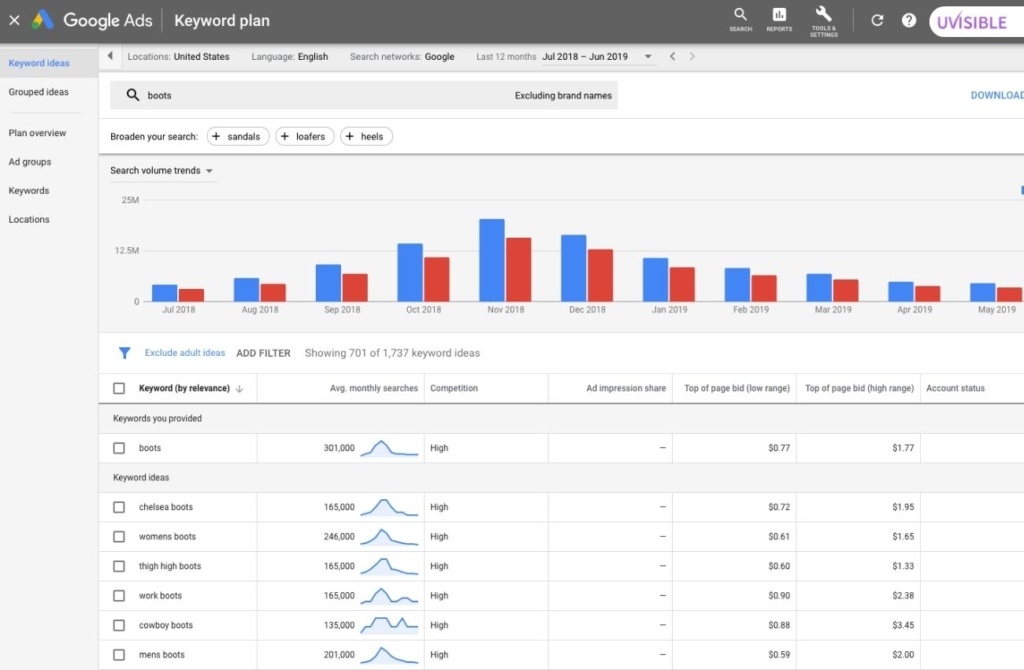
While Google keyword planner is not a long tail keyword research tool primarily but if you use it well, you can pull out long tail keywords that have low search volumes and low keyword difficulty.
Google Suggest
You must have noticed that Google suggests you some words while you search.
Google also shows some related keywords searched by users at the bottom of the search results page.
These keywords are nothing but suggestions by Google which means that these are also related keywords used by searchers.
AnswerThePublic
AnswerThePublic is your hidden weapon in the realm of SEO.
This dynamic tool piques people’s interest by revealing the questions they have about any particular topic.
AnswerThePublic develops a captivating visual of relevant inquiries and displays them in an engaging manner by just inputting a keyword. It shows the burning questions your target audience has, from the “who” and “what” to the “why” and “how,” allowing you to generate highly engaging and relevant content.
With AnswerThePublic as your SEO partner, you can say goodbye to guesswork and embrace the power of data-driven insights.
Alsoasked.com
This is the newest SEO software launched by Mark Williams and this tool is evolving at a rapid pace.
Mark Williams is a hardcore SEO and digital marketer and understands the requirements of an SEO professional very well.
Ubersuggest
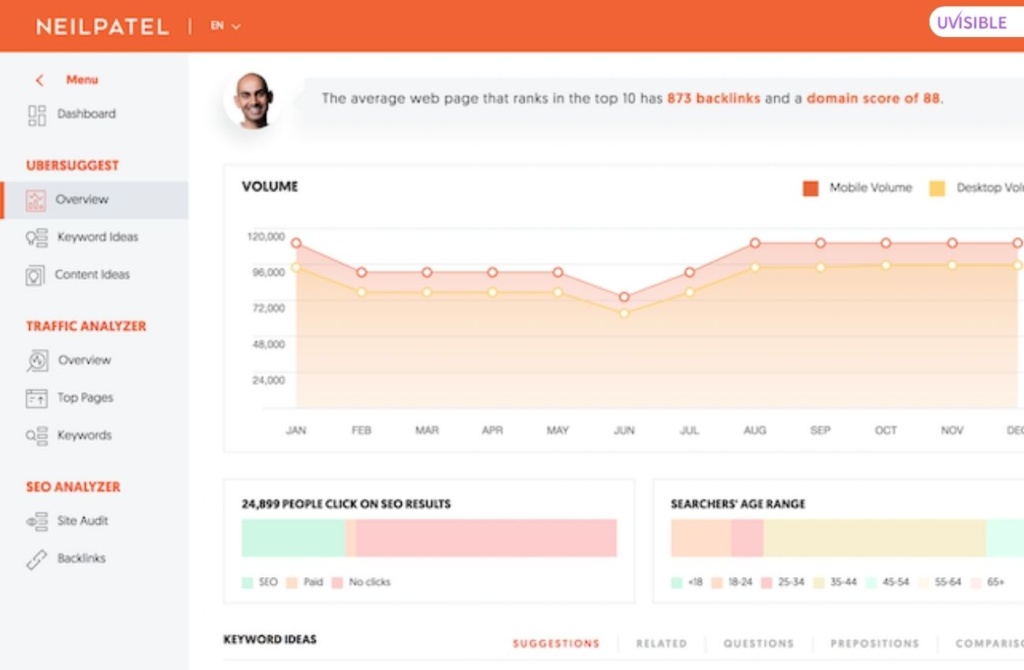
This is a tool by Neil Patel which is on the lines of Google keyword planner i.e. it is a go-to for finding long tail keywords because it is easy to use and has strong features.
It gives thorough keyword ideas, details on how often people look for those keywords, and even a competitive analysis.
With Ubersuggest, you’ll be able to find long tail keywords you didn’t know about and optimise your content like a pro.
HubSpot Content Strategy Tool
It is a terrific place to start if you’re searching for a comprehensive keyword solution.
It assists you in identifying long tail keywords that are relevant to your content goals and gives information on search traffic and difficulty.
It’s like having your keyword adviser at your disposal!
Semrush
Semrush, the SEO tool’s Swiss Army knife.
It not only has a tonne of functionality, but it’s also a goldmine for identifying long tail keywords.
You may use its excellent keyword research skills to find low-competition, high-value long tail phrases that will boost your efforts, especially if you are a purpose-driven agency offering SEO for Startups services.
KWFinder
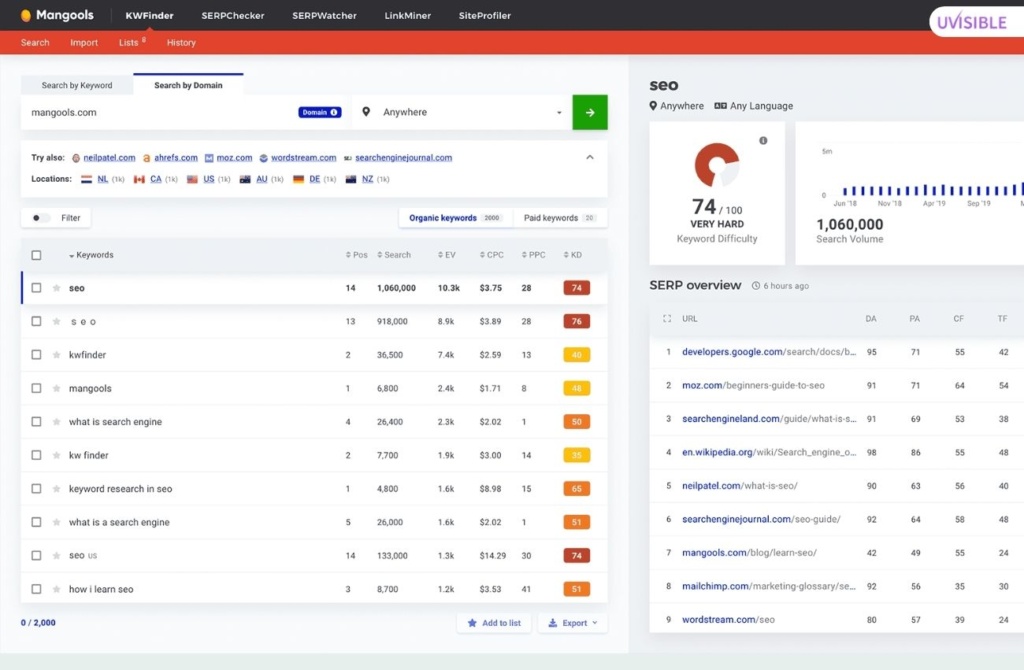
KWFinder is a hidden gem for locating long tail keywords.
It specialises in assisting you in locating less competitive yet highly relevant keywords.
You’ll feel like a keyword detective in no time thanks to its user-friendly UI and extensive keyword research.
GrowthBar
Looking for a solution that works in tandem with your browser?
Take a look at GrowthBar.
Long tail keywords may be found immediately from search engine results pages with a few clicks.
It’s like having a personal keyword researcher right in your browser!
Keyword Tool Dominator
Are you looking for a tool that specialises in long tail keyword research? Keyword Tool Dominator is here to help.
It provides detailed term ideas for a variety of sites, including Google, Amazon, and YouTube.
This application is ideal for anyone involved in e-commerce or video content creation.
WordTracker

WordTracker is an excellent tool for finding long tail keywords.
It gives useful information on search traffic, competition, and even trends.
With its huge database, you’ll find hidden long tail keywords that will provide your SEO approach a competitive advantage.
LongTailPro
LongTailPro, as the name implies, is all about long tail keywords.
It has a robust feature set that includes keyword research, competition analysis, and rank tracking.
Prepare to unleash the full power of long tail keywords with this amazing tool.
SECockpit
SECockpit is a must-have tool in the arsenal of every SEO specialist.
It gives thorough SEO data and competitive research in addition to discovering long tail keywords.
You’ll be able to create a winning SEO strategy centred on long tail keywords thanks to its extensive capabilities.
LowFruits
Looking for a tool that is both simple and effective? LowFruits is the solution.
You’ll uncover long tail keywords that can help you rank better in search results with its simple UI and effective keyword suggestions.
In the term jungle, it’s like selecting low-hanging fruit!
Raven Tools
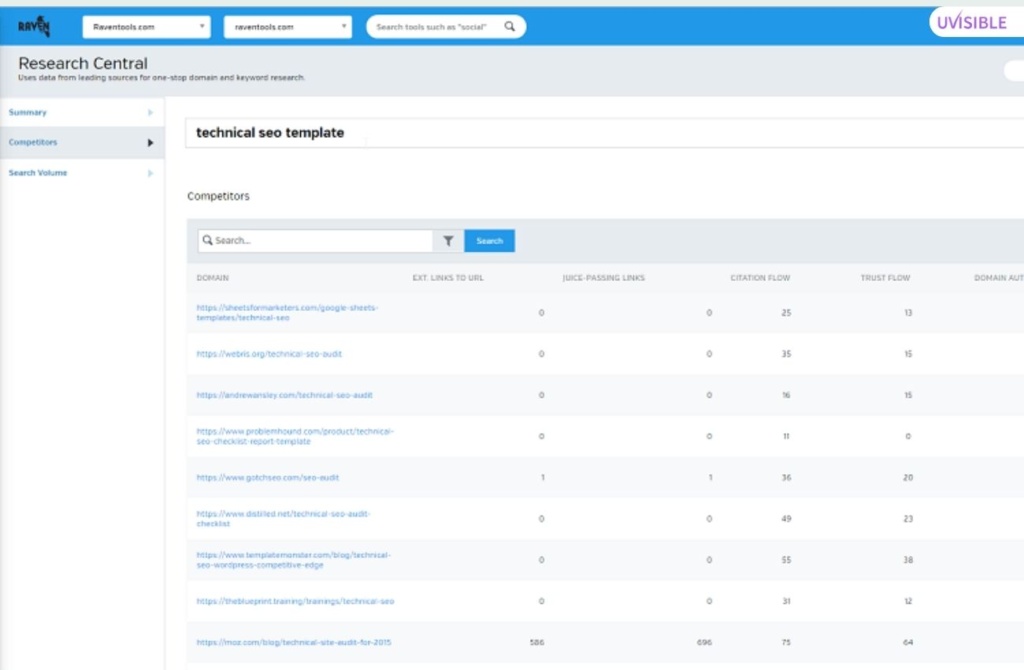
Last but not least, Raven Tools is a force to be reckoned with when it comes to keyword research.
It provides an extensive set of SEO tools, including a keyword research tool that finds both short and long tail keywords.
You’ll have everything you need to conquer the world of long tail SEO with Raven Tools on your side.
How to Use Long Tail Keywords in Your Content?

Once you figure out the list of long tail keywords that you want to target, the next step is to understand how to use these keywords in your content.
Just like any other on-page optimization, long tail keywords too should be used.
To reiterate, here are a few elements in which long tail keywords should be used
- Page Title
- Meta Description
- Heading Tags (H1-H6)
- Images (file names and alt tags)
- Static content of the page – This is nothing but the body content.
- Internal Links
- External Links
To have a more clear understanding of how to use long tail keywords, here is a four-step plan for using long-tail keywords in SEO in your content approach.
By setting goals, knowing your audience through buyer personas, doing keyword research, and making useful content, you’ll be well on your way to unlocking the potential of long-tail keywords and winning the hearts and minds of your target audience.
Step 1: Get your Content Marketing Goals Out in the Open
Before getting into long-tail keywords, it’s important to set clear goals for your content marketing.
What do you want your work to accomplish? Do you want to get more people to visit your site, improve the number of people who buy from you, or become a leader in your industry?
By writing down your goals, you’ll have a strong base for your long tail keyword approach.
For example, let’s say you have a fitness blog and your goal with content marketing is to get more people to your site and connect with fitness fans who are looking for workout tips and healthy meals.
Step 2: Use Buyer Personas to your Advantage
To know what a person wants when they look, you have to put yourself in their shoes.
This is why customer identities are important.
These made-up versions of your ideal audience help you understand their wants, needs, and pain points.
By making buyer personas, you can tailor your content to their unique hobbies and help them along their buyer’s journey.
For example, let’s say you have two buyer characters for your fitness blog: “Gym-Goer Gina” and “Home Workout Harry.”
Gina likes to lift weights and wants to get stronger, while Harry likes to work out at home and is looking for quick, effective practices.
Step 3: Start a Keyword Research Journey
Now that you know what your goals are and who your buyer personas are, it’s time to go on a keyword study trip.
Start by coming up with ideas for topics that fit in with your content marketing goals and client types.
Then, use keyword research tools like Semrush or Ubersuggest to find appropriate long tail keywords that get a good number of searches and don’t have too much competition.
Using our fitness blog as an example again, you might find long tail keywords like “strength training exercises for beginners at the gym” or “quick fat-burning workouts at home.”
These terms are specific, match the goals of your target audience, and could bring people who are interested in what you have to say to your content.
Step 4: Weave Your Content Magic
With a list of carefully chosen long tail keywords in hand, it’s time to work your magic on your content.
Make blog posts, articles, or videos that are interesting and give your audience useful information about these terms.
To quickly generate varied forms of content you can rely on some of the latest SEO content writing software, it will aid you by providing a solid base along with some compelling ideas to build engaging content.
Make sure to put the keywords in your writing in a natural way so that it runs well and is easy to read.
Let’s say you’re writing a blog post called “10 Effective Strength Training Exercises for Beginners.”
In this post, you’ll naturally include the long tail keyword “strength training exercises for beginners at the gym” by giving thorough descriptions, step-by-step directions, and even video examples.
By focusing on Gina, a person who goes to the gym, you’ll be more likely to attract and keep the attention of your target audience.
Why Use Long Tail Keywords?
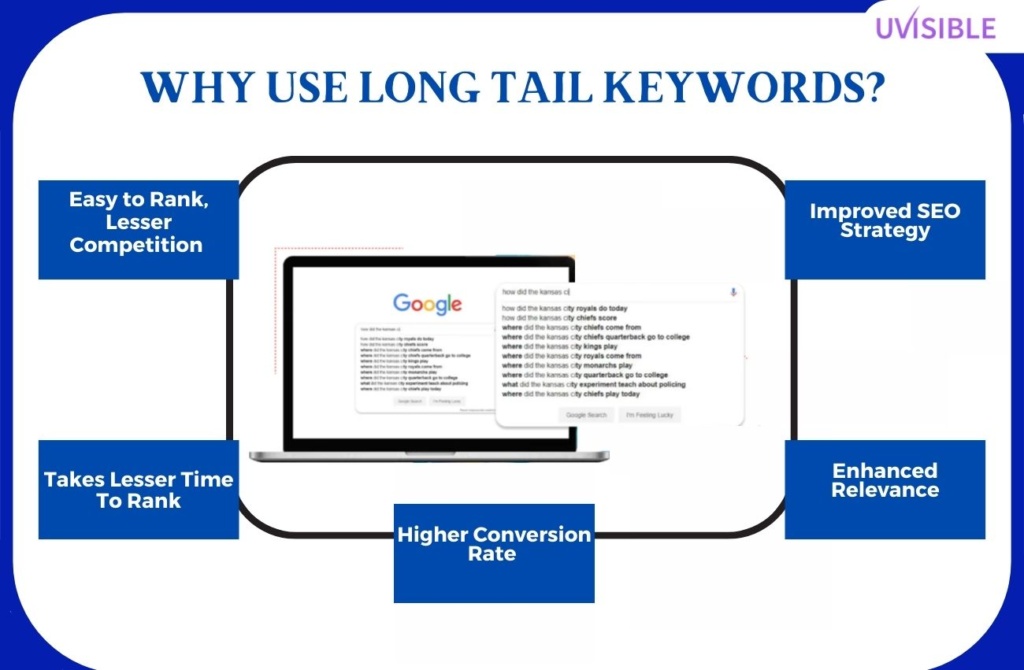
Long-tail SEO is a secret gem, especially in this era of digital marketing.
These hidden stars may not get as much attention as their flashier peers, the short tail keywords a.k.a. high search volume keywords, but they have a huge potential to bring in targeted traffic and earn valuable rewards.
So, let’s dive into the interesting world of long-tail keywords and find out why use long tail keywords:
Easy to Rank, Lesser Overall Competition
Imagine that you want to do well in search engine results and claim your online space.
Well, you can trust long tail keywords to help you in this quest.
Long tail keywords are less busy than short tail keywords, which are in a very competitive market.
They’re like a secret way to get to a higher spot without having to fight the giants.
So, when you optimise your content around long tail keywords, you improve your chances of ranking better and sticking out in search results.
Takes Lesser Time in Comparison to Short Tail
In the fast-paced digital world, time is of the essence, and this is where long tail keywords shine.
Think about it: when a user types in a specific search term, they are already in a state of thought where they are ready to focus.
By making your content fit these unique wants, you can give your readers relevant information right away.
This saves them time by giving them exactly what they’re looking for, and it saves you time by bringing in people who are more likely to read your content and buy from you.
It’s a case where everyone wins and time is on your side.
Higher Conversion Rate
Long tail keywords have a secret superpower: they bring you highly targeted traffic that is more likely to turn into sales.
Users are further along in their buyer’s journey when they look with a specific goal in mind.
By making sure your content meets their wants and gives them useful answers, you’ll be able to grab their attention and lead them to a sale.
Long tail keywords help you meet with an audience that’s ready to take action, whether it’s a sale, a sign-up, or a connection.
Enhanced Relevance
Still unsure regarding why use long tail keywords?
Check out this benefit, it lets you focus on what your target audience wants and needs.
By making your content fit these keywords, you make a better link with your audience and give them useful information that directly answers their problems.
This makes you look like an expert in your area, which builds trust and a loyal following.
Improved SEO Strategy
Long tail terms are an important part of an SEO plan that works.
By using these specific search terms in your content, meta tags, titles, and URLs, search engines can better understand what your content is about.
This optimisation makes it more likely that you’ll show up higher in relevant search results and brings more people to your website on their own.
Deepened Audience Understanding
Long tail keywords let you see the thoughts of the people you want to reach.
By looking at the long tail keywords they use to find your content, you can learn a lot about their tastes, hobbies, and problems.
This gives you a better idea of how to make your content, products, and marketing tactics fit their wants and help you build stronger relationships.
Summary!
SEO begins with keywords, the right long tail keywords would give you traffic and the wrong keywords will take you nowhere.
As Abraham Lincoln said, “Give me six hours to chop down a tree and I will spend the first four sharpening the axe.”
In the same way, I would say that finding the right + relevant keywords is the activity where you should spend a lot of time.
Do not go crazy over high search volume keywords from day 1.
You must be focused and try to find long tail keywords as they are worth the investment because they would be easier to rank + give you traffic that converts.
Thus, with these wonderful long-tail keywords in SEO strategy at your disposal, you’re well-equipped to find long tail keywords examples that will set your content apart from the competitors.
I wish you a ‘happy keyword searching’, and may the long tail SEO magic always be with you!
Struggling with long tail keywords?
Reach out to Uvisible, your performance-driven Content Marketing Services Agency.
We’ll help you find the perfect search terms to boost your traffic and conversions. Let’s elevate your content together!
About us and this blog
We are a digital marketing company with a focus on helping our customers achieve great results across several key areas.
Request a free quote
We offer professional SEO services that help websites increase their organic search score drastically in order to compete for the highest rankings even when it comes to highly competitive keywords.
Subscribe to our newsletter!
More from our blog
See all postsRecent Posts
- 𝗖𝗼𝗺𝗽𝗹𝗲𝘁𝗲 𝗚𝘂𝗶𝗱𝗲 𝘁𝗼 𝗖𝗼𝗻𝗱𝘂𝗰𝘁 𝗮 𝗧𝗲𝗰𝗵𝗻𝗶𝗰𝗮𝗹 𝗦𝗘𝗢 𝗮𝘂𝗱𝗶𝘁 𝗳𝗼𝗿 𝗖𝗹𝗶𝗲𝗻𝘁𝘀 October 17, 2024
- HVAC Digital Marketing Strategies – Elevate your Business Profits Today! February 1, 2024
- Travel Digital Marketing Strategies for a 30% Surge in Your Agency Revenue January 10, 2024














Pingback: How to Outsource Google Ads? - Uvisible
Pingback: How to Create SEO Friendly Website? - Uvisible
Pingback: Complete PPC Strategy for Ecommerce - Uvisible
Pingback: 100+ PPC Terms: Demystifying the Terminology of PPC Advertising - Uvisible
Pingback: How to Improve SEO on Shopify? - Uvisible
Pingback: SEO for eCommerce Product Pages Ultimate Guide - Uvisible
Pingback: Ultimate Guide to SEO for SaaS - Uvisible
Pingback: SEMRush Pricing and Review - Uvisible
Pingback: Why is SEO important for SaaS companies? - Uvisible
Pingback: Best SEO Extensions for Beginners - Uvisible
Pingback: The Ultimate Guide to Mastering SEO Terminology - Uvisible
Pingback: Best SEO Tools You MUST use in 2023 - Uvisible
Pingback: How to Rank for Long Tail Keywords? - Uvisible